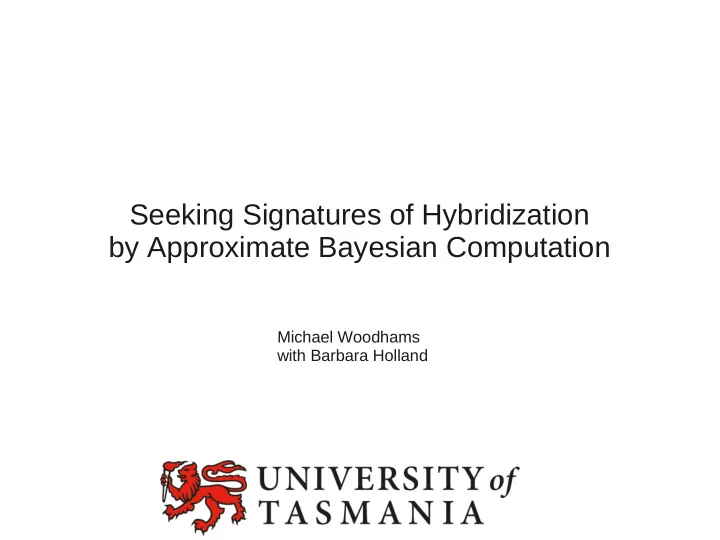

Seeking Signatures of Hybridization by Approximate Bayesian Computation Michael Woodhams with Barbara Holland
Simulation 1 Analysis Base Stats Data New summary stats Simulation 2 ABC Results
Simulator Fixed params Simulator Set of Gene Trees Set of Gene Trees Random params
Simulator Fixed params Simulator Set of Gene Trees Set of Gene Trees Random params Hybrid Network Resolve hybridizations Lineage Trees Simulate coalescence Gene Trees
Simulator Fixed params Simulator Set of Gene Trees Set of Gene Trees Random params #NEXUS begin hybridseq; epochs = (); speciation rate = (1); hybridization rate = (0.1); introgression rate = (0); Hybrid hybridization function = step; Network hybridization threshold = 100; hybridization distribution =(0.5,1); Resolve hybridizations minimum hybridizations = 3; coalesce = true; halt time = 100; Lineage [ halt taxa = 23;] Trees halt hybrid = 100; [ number random trees = 1070;] end; Simulate coalescence begin ABC; iterations = 50000; Gene reduce hybridizations to = HYBR(0,3); Trees coalescence rate = COAL(1,20); ... end; begin trees; ...
Coalescence Hybridization 5 x 3 x (we hope that other sources of phylogenetic error will behave like coalescence)
Base Stats TE: Tree Entropy. Entropy of gene tree topologies QE: Quartet Entropy: sum over quadruples of taxa, entropy of how that quadruple resolves into quartets. SI: Split incompatibility. Sum over pairs of gene trees of their Robinson-Foulds distance. Equivalently, number of incompatible pairs of splits from the gene trees SI- k : Threshold split incompatibility: like SI but subtract k from number of times each split occurs RS k : Rare splits. The number of splits occurring k or fewer times DC : Distance to Consensus. The sum over gene trees of Robinson-Foulds distance to majority-rule consensus tree. TS : Total Splits. The number of distinct splits in the gene trees TC : Total Cherries. The number of distinct cherries in the gene trees SPR, NNI distances would be ideal, but too computationally expensive. Suggestions welcome.
Base Stats No hybrid, two hybrid Coal. rate and hybr rate: high, med, low, tiny ▲fast coal, ● slow coal
ABC Overview Data Summary Stats Random Analyse Simulation Close enough? Parameters Parameters
ABC Overview Data Summary Stats Random Analyse Simulation Close enough? Parameters Parameters Randomized Which How close? over what summary range? stats?
Summary Stats Semi-automatic ABC: Fearnhead & Prangle, JRStatS B, 74 419-474 (2012) Random Simulation Parameters Simulated Data Fit parameters
Summary Stats Semi-automatic ABC: Fearnhead & Prangle, JRStatS B, 74 419-474 (2012) Random Simulation Parameters Simulated Data Fit parameters Gene Trees Hybridization, Simulation coalescence Base stats Fit parameters Fitted = summary statistics for ABC hybridization, coalescence
Summary Stats Coloured by Coalescence Rate Coloured by Hybridization Number (red = slow coalescence = randomized trees) Principal Component Analysis
Data Inferring ancient divergences...: Salichos & Rokas, Nature, 497 327-331 (2013) Yeast 23 taxa 1070 genes
Results Hybr = 0 has p=0.25
Data Inferring ancient divergences...: Salichos & Rokas, Nature, 497 327-331 (2013) Vertebrates 18 taxa 1087 genes
Results Hybr > 0 has p=0.23
Data Inferring ancient divergences...: Salichos & Rokas, Nature, 497 327-331 (2013) Metazoa 21 taxa 225 genes
Results
Recommend
More recommend